OLDSMOBILE SILHOUETTE 1998 Service Manual
Manufacturer: OLDSMOBILE, Model Year: 1998, Model line: SILHOUETTE, Model: OLDSMOBILE SILHOUETTE 1998Pages: 444, PDF Size: 23.2 MB
Page 41 of 444
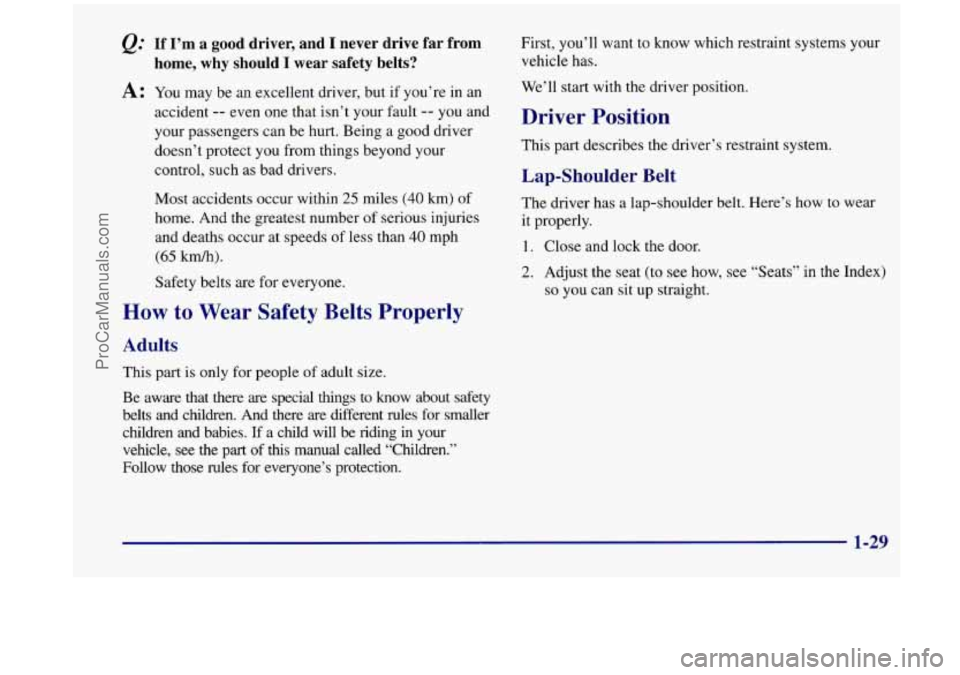
Q: If I’m a good driver, and I never drive far from
A: You may be an excellent driver, but if you’re in an
home, why should I wear safety belts?
accident -- even one that isn’t your fault -- you and
your passengers can be hurt. Being a good driver
doesn’t protect you from things beyond your
control, such as bad drivers.
Most accidents occur within
25 miles (40 km) of
home. And the greatest number of serious injuries
and deaths occur at speeds of less than
40 mph
(65 kdh).
Safety belts
are for everyone.
How to Wear Safety Belts Properly
Adults
This part is only for people of adult size.
Be aware that there
are special things to know about safety
belts and children. And there are different rules for smaller
children and babies. If a child will be riding
in your
vehicle, see the part of this manual called “Children.”
Follow those rules for everyone’s protection. First, you’ll want to know which restraint systems your
vehicle has.
We’ll start with the driver position.
Driver Position
This part describes the driver’s restraint system.
Lap-Shoulder Belt
The driver has a lap-shoulder belt. Here’s how to wear
it properly.
1. Close and lock the door.
2. Adjust the seat (to see how, see “Seats” in the Index)
so you can sit up straight.
1-29
ProCarManuals.com
Page 42 of 444

3. Pick up the latch plate and pull the belt across you.
Don’t let it get twisted.
The shoulder belt may lock
if you pull the belt across
you very quickly. If this happens, let the belt
go back
slightly to unlock it. Then pull the belt across you
more slowly.
4. Push the latch plate into the buckle until it clicks. Pull
up on the latch plate to make sure it is secure. If
the belt isn’t long enough, see “Safety Belt
Extender’’ at the end
of this section.
Make sure the release button on the buckle is
positioned so you would be able to unbuckle the
safety belt quickly if you ever had to.
5. To make the lap part tight, pull down on the buckle
end
of the belt as you pull up on the shoulder belt.
1-30
ProCarManuals.com
Page 43 of 444
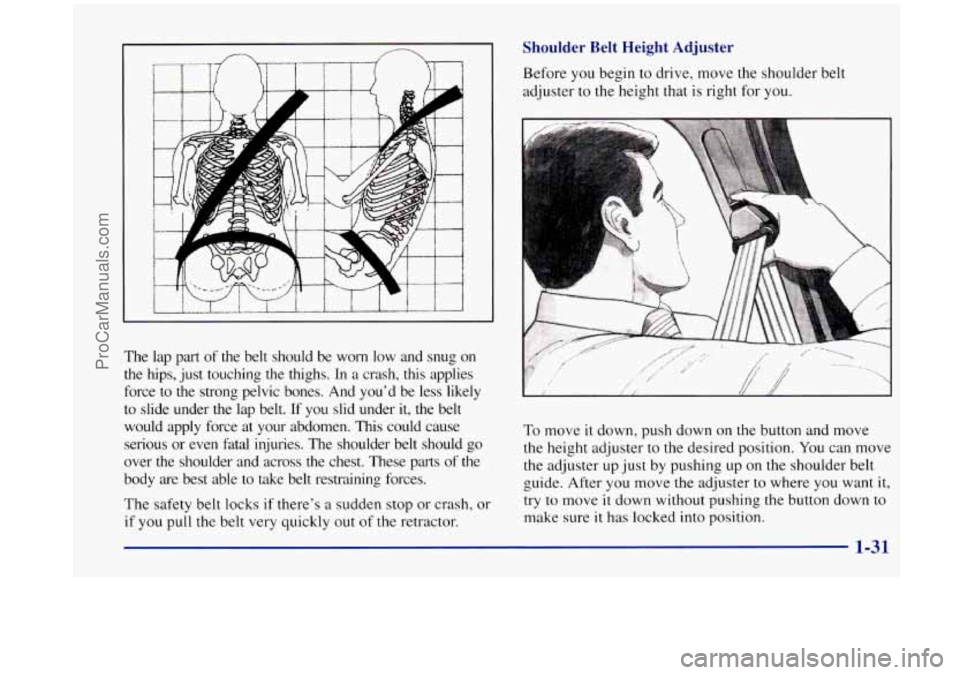
The lap part of the belt should be worn low and snug on
the hips, just touching
the thighs. In a crash, this applies
force to the strong pelvic bones. And you'd be less likely
to slide under the lap belt. If you slid under it, the belt
would apply force at your abdomen. This could cause
serious or even fatal injuries. The shoulder belt should
go
over the shoulder and across the chest. These parts of the
body are best able to take belt restraining forces.
The safety belt locks if there's a sudden stop or crash, or
if you pull the belt very quickly out of the retractor.
Shoulder Belt Height Adjuster
Before you begin to drive, move the shoulder belt
adjuster
to the height that is right for you.
To move it down, push down on the button and move
the height adjuster to the desired position. You can move
the adjuster up just by pushing up on the shoulder belt
guide. After
you move the adjuster to where you want it,
try to move it down without pushing the button down to
make sure it has locked into position.
ProCarManuals.com
Page 44 of 444
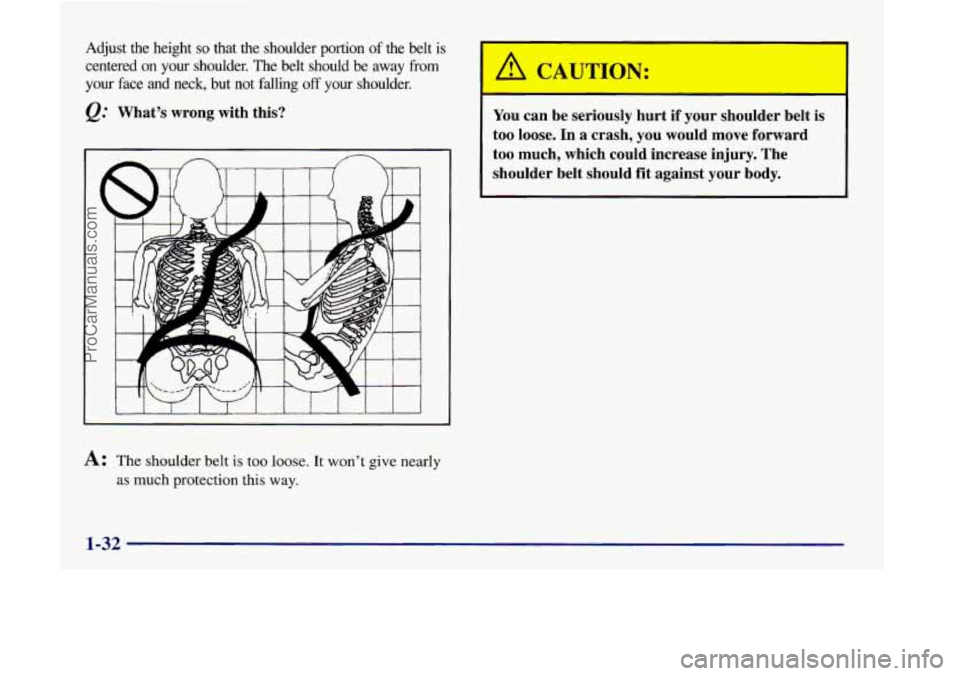
Adjust the height so that the shoulder portion of the belt is
centered on your shoulder. The belt should be away
from
your face and neck, but not falling off your shoulder.
&: What's wrong with this?
1 I I 1 I 1 i I i I I
A: The shoulder belt is too loose. It won't give nearly
as much protection this way.
You can be seriously hurt if your shoulder belt is
too loose. In a crash, you would move forward
too much, which could increase injury. The
shoulder belt should fit against your body.
1-32
ProCarManuals.com
Page 45 of 444

&: What’s wrong with this?
A: The belt is buckled in the wrong place.
You can be seriously injured if your belt is
buckled in the wrong place like this. In a crash,
the belt would
go up over your abdomen. The
belt forces would be there, not at the pelvic
bones. This could cause serious internal injuries.
Always buckle your belt into the buckle
nearest you.
1-33
ProCarManuals.com
Page 46 of 444
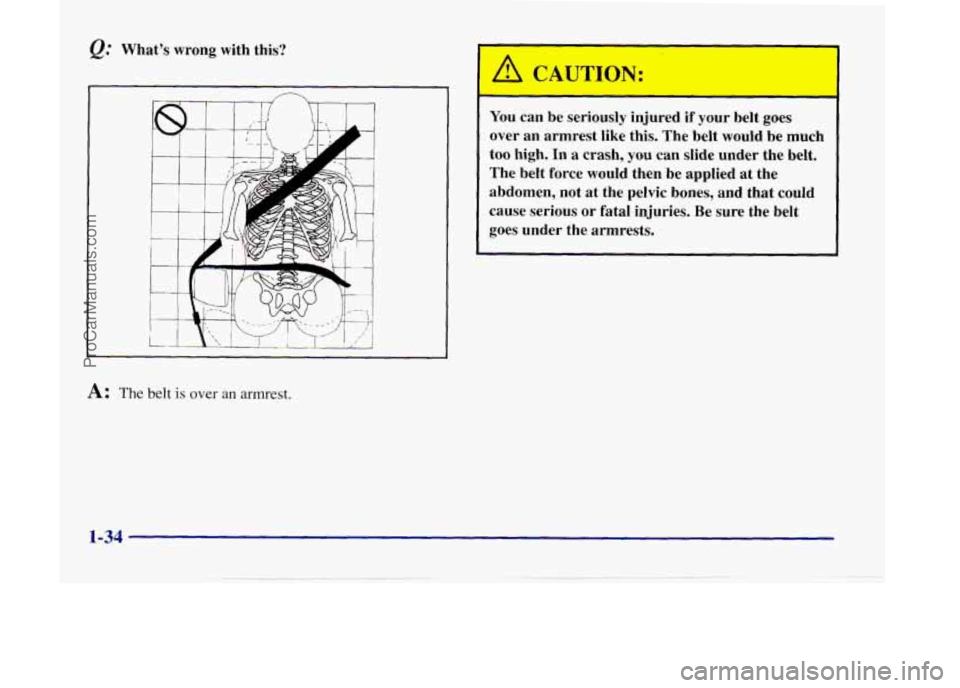
Q: What's wrong with this?
r
A CAUT 'Y:
-- I
You can be seriously injured if your belt goes
over an armrest like this. The belt would be much
too high. In
a crash, you can slide under the belt.
The belt force would then be applied at the
abdomen, not at the pelvic bones, and that could
cause serious
or fatal injuries. Be sure the belt
goes under the armrests.
A: The belt is over an armrest.
1-34
ProCarManuals.com
Page 47 of 444
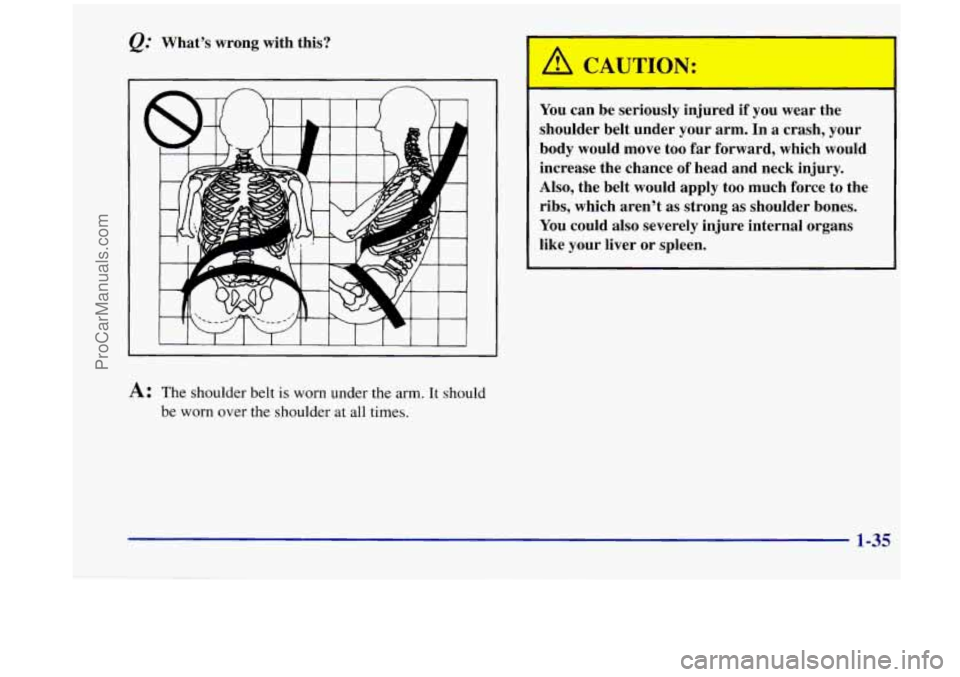
Q: What’s wrong with this?
A: The shoulder belt is worn under the arm. It should
be worn over the shoulder at all times.
A CAUTION:
I
You can be seriously injured if you wear the
shoulder belt under your arm. In
a crash, your
body would move too
far forward, which would
increase the chance of head and neck injury.
Also, the belt would apply too much force to the
ribs, which aren’t as strong as shoulder bones.
You could also severely injure internal organs
like your liver or spleen.
1-35
ProCarManuals.com
Page 48 of 444
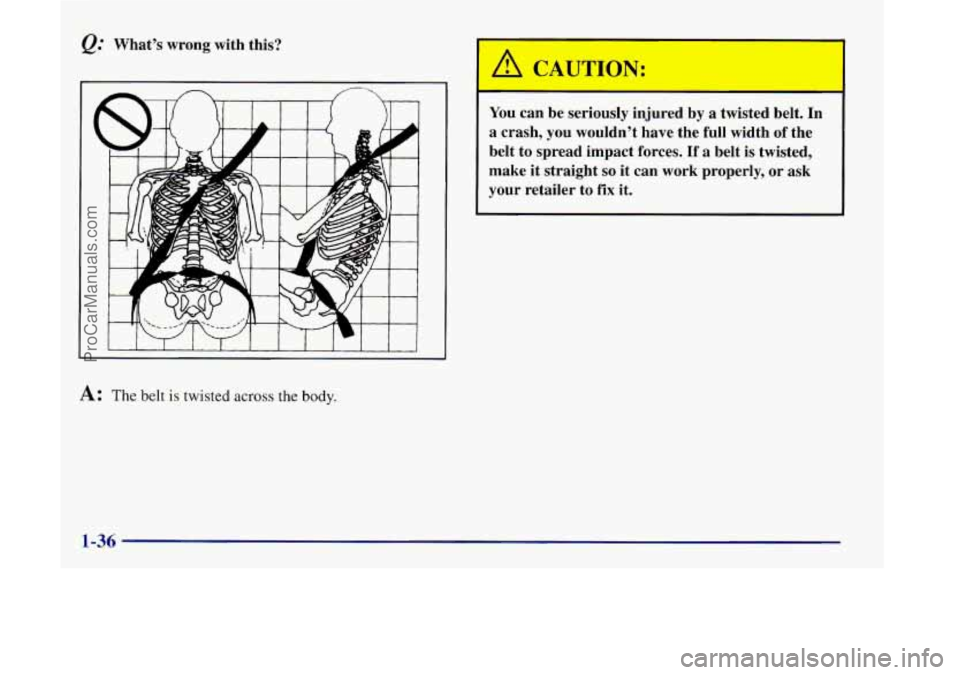
What’s wrong with this?
A: The belt is twisted across the body.
You can be seriously injured by a twisted belt. In
a crash, you wouldn’t have the full width
of the
belt to spread impact forces.
If a belt is twisted,
make it straight
so it can work properly, or ask
your retailer to
fix it.
1-36
ProCarManuals.com
Page 49 of 444
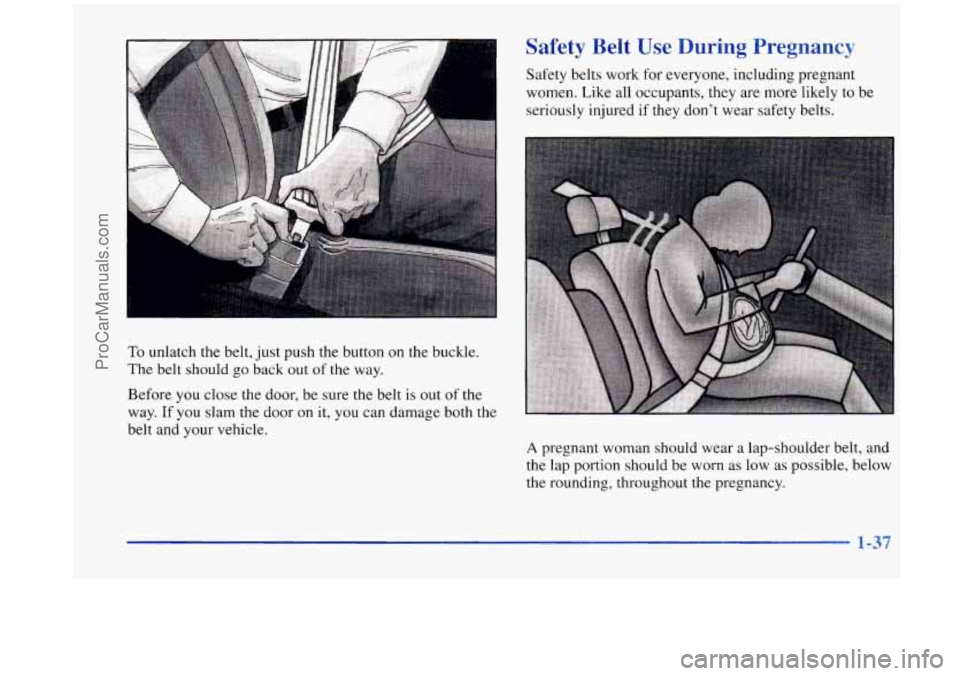
L
To unlatch the belt, just push the button on the buckle.
The belt should go back out of the way.
Before you close the door, be sure the belt is out
of the
Safety Belt Use During Pregnancy
Safety belts work for everyone, including pregnant
women. Like all occupants, they are more likely to be
seriously injured if they don’t wear safety belts.
way. If you slam the door on it, you can damage both the
belt and your vehicle.
A pregnant woman should wear a lap-shoulder belt, and
the lap portion should be worn
as low as possible, below
the rounding, throughout the pregnancy.
1-37
ProCarManuals.com
Page 50 of 444

The best way to protect the fetus is to protect the
mother. When a safety belt is worn properly, it’s more
likely that the fetus won’t be hurt in a crash. For
pregnant women, as for anyone, the key to making
safety belts effective
is wearing them properly.
Right Front Passenger Position
To learn how to wear the right front passenger’s
safety belt properly, see “Driver Position” earlier
in
this section.
The right front passenger’s safety belt works the same
way as the driver’s safety belt
-- except for one thing. If
you ever pull the shoulder portion of the belt out all the
way, you will engage the child restraint locking feature.
If this happens, just let the belt
go back all the way and
start again.
Supplemental Restraint Systems (SRS)
This part explains the frontal and side impact
Supplemental Restraint Systems (SRS) or
air bag systems.
Your vehicle has four air bags
-- a “Next Generation”
reduced-force frontal air bag for the driver, another
“Next Generation” reduced-force frontal frontal air bag
for the right front passenger, a side impact air bag for
the driver, and another side impact air bag for the right
front passenger. Reduced-force
frontal air bags are designed to help
reduce the risk of injury from the force of an inflating
frontal air bag. But even these air bags must inflate very
quickly if they are
to do their job and comply with
federal regulations.
Here are the most imponant things to know about the air
bag systems:
A “I C’ u T1C”T:
rn
You can be severely injured or killed in a crash if
you aren’t wearing your safety belt
-- even if you
have air bags. Wearing your safety belt during
a
crash helps reduce your chance of hitting things
inside the vehicle or being ejected from
it. Air
bags are “supplemental restraints” to the safety
belts.
All air bags -- even reduced-force air
bags
-- are designed to work with safety belts but
don’t replace them.
CAUTION: (Continued)
1-38
ProCarManuals.com